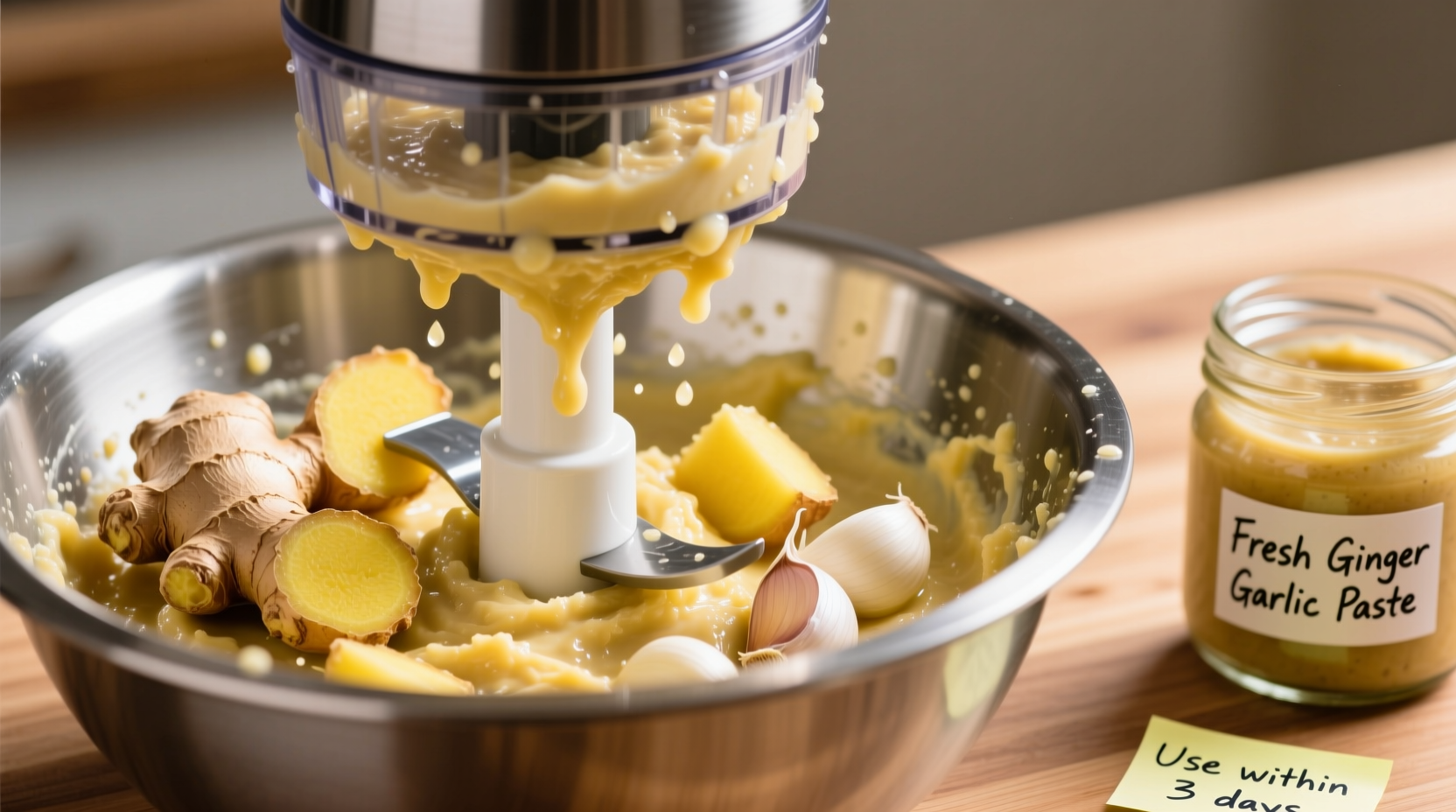Make perfect homemade ginger garlic paste with this simple recipe: Peel and blend equal parts fresh ginger and garlic with a splash of neutral oil until smooth. Store in an airtight container in the refrigerator for up to 3 weeks or freeze for 6 months. This essential Indian cooking staple adds authentic flavor to curries, marinades, and sauces.
Creating your own ginger garlic paste transforms everyday cooking. Unlike store-bought versions filled with preservatives, fresh homemade paste delivers vibrant, complex flavors that elevate dishes from ordinary to extraordinary. Professional chefs rely on this kitchen essential for its convenience and depth of flavor.
Why Homemade Ginger Garlic Paste Beats Store-Bought
Commercial ginger garlic pastes often contain additives, stabilizers, and excessive salt that dull authentic flavors. When you make your own, you control the quality and freshness. According to the U.S. Food and Drug Administration, fresh spice pastes maintain optimal flavor compounds for up to 3 weeks when properly stored—significantly longer than most consumers realize.
| Characteristic | Homemade Paste | Store-Bought Paste |
|---|---|---|
| Ingredients | Just ginger, garlic, oil | Preservatives, salt, stabilizers |
| Flavor Profile | Bright, complex, fresh | Muted, sometimes metallic |
| Shelf Life | 3 weeks refrigerated, 6 months frozen | 6-12 months (with additives) |
| Cost per Ounce | $0.35 | $0.75-$1.20 |
Essential Ingredients and Tools
You need just three basic ingredients:
- Fresh ginger root (choose firm, smooth-skinned pieces)
- Fresh garlic cloves (plump with tight skins)
- Neutral oil (grapeseed or avocado oil works best)
Equipment essentials:
- Sharp vegetable peeler
- Quality food processor or blender
- Airtight glass containers for storage
- Ice cube trays for portioning frozen paste
Step-by-Step Preparation Guide
- Prepare ingredients: Peel 1 cup ginger and 1 cup garlic cloves. Discard any sprouted or discolored pieces.
- Chop roughly: Cut ginger into 1-inch pieces for easier processing.
- Process in batches: Combine equal parts ginger and garlic with 2 tablespoons oil per cup of mixture.
- Blend to smoothness: Process until completely smooth, scraping down sides as needed.
- Adjust consistency: Add additional oil (1 teaspoon at a time) if too thick.

Proper Storage Techniques
Food safety experts from the World Health Organization emphasize proper storage to prevent bacterial growth in fresh spice pastes. Follow these guidelines:
- Refrigeration: Store in airtight glass container for up to 3 weeks
- Freezing: Portion into ice cube trays, freeze solid, then transfer to freezer bags (keeps 6 months)
- Oil layer method: Top refrigerated paste with 1/4 inch oil to create protective barrier
- Always use clean utensils when scooping to prevent contamination
Culinary Applications and Pairing Suggestions
Ginger garlic paste serves as the flavor foundation in countless global cuisines. Professional chefs use it differently based on regional traditions:
- Indian cooking: Use 1-2 tablespoons as base for curries and marinades
- Chinese stir-fries: Add 1 teaspoon at beginning of cooking for subtle background flavor
- Middle Eastern dishes: Mix with lemon juice and olive oil for salad dressings
- Caribbean jerk seasoning: Combine with allspice, thyme, and scotch bonnet peppers
Troubleshooting Common Issues
Even simple recipes encounter challenges. Here's how to solve frequent problems:
- Paste too watery: You've likely added too much oil. Simmer gently in a pan for 2-3 minutes to evaporate excess liquid.
- Bitter taste: Older garlic can develop bitterness. Always use fresh, firm cloves and avoid burning during cooking.
- Separation: Natural separation occurs. Simply stir well before using—this indicates no artificial stabilizers.
- Mold development: Discard immediately. This indicates improper storage or contaminated utensils.
Regional Variations Worth Trying
Adapt your ginger garlic paste for specific culinary traditions:
- Thai-inspired: Add 1 stalk lemongrass (finely minced) and 1 teaspoon galangal per cup of paste
- Middle Eastern: Incorporate 1 teaspoon sumac and 1/2 teaspoon ground cumin per batch
- Mexican twist: Blend in 1-2 chipotle peppers in adobo sauce for smoky depth
- Japanese variation: Substitute 25% of ginger with fresh grated turmeric root
Frequently Asked Questions
How long does homemade ginger garlic paste last in the refrigerator?
Properly stored in an airtight glass container with a thin layer of oil on top, homemade ginger garlic paste maintains freshness for 2-3 weeks in the refrigerator. Always use clean utensils when scooping to prevent contamination that could shorten shelf life.
Can I freeze ginger garlic paste for long-term storage?
Yes, freezing is the best method for long-term storage. Portion the paste into ice cube trays, freeze solid, then transfer cubes to freezer bags. Properly frozen ginger garlic paste maintains optimal flavor for 6 months. Thaw individual portions as needed for recipes.
Why does my ginger garlic paste taste bitter?
Bitterness typically comes from using old or sprouted garlic cloves. Always select firm, plump garlic with tight skins. Over-processing can also release bitter compounds—blend just until smooth, not liquefied. If bitterness occurs, adding a small pinch of sugar can help balance the flavor in your final dish.
What's the ideal ginger to garlic ratio for cooking paste?
The standard 1:1 ratio (equal parts ginger and garlic by volume) works for most applications. For stronger ginger flavor in Indian curries, use a 2:1 ginger to garlic ratio. For more subtle background flavor in Chinese cooking, try a 1:2 ratio with more garlic. Adjust based on your personal taste preferences and specific recipe requirements.
Can I use dried ginger or garlic powder instead of fresh?
While convenient, dried spices cannot replicate the complex flavor profile of fresh ginger garlic paste. The enzymatic reactions in fresh ingredients create flavor compounds that powders lack. If absolutely necessary, use 1/4 teaspoon ginger powder and 1/8 teaspoon garlic powder per clove of fresh garlic, but expect significantly different results in both flavor and texture.











 浙公网安备
33010002000092号
浙公网安备
33010002000092号 浙B2-20120091-4
浙B2-20120091-4